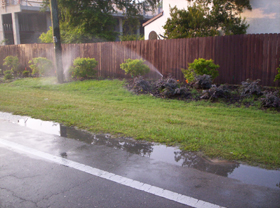Introduction

Water stress affects plant growth and avoiding severe water stress is an important component of establishing woody plants. Inadequate irrigation will slow establishment and growth of newly installed woody plants by restricting root growth (Balok and Hilaire, 2002; Witherspoon and Lumis, 1986). In addition, there will likely be a corresponding reduction in vegetative and reproductive growth (Shackel et al., 1997).
Multiple studies report increased growth in response to increased irrigation frequency during establishment (Stabler and Martin, 2000; Marshall and Gilman, 1998; Gilman et al., 1996; Barnett, 1986). Irrigation frequency may have a greater effect on woody plant establishment than irrigation volume (Renquist, 1987). Gilman et al., 1998, found that irrigation volume did not significantly affect plant growth parameters or stem water potential of Quercus virginiana (live oak). Similarly, changes in irrigation volume were not reflected in significant changes in growth of P. fraseri (Welsh et al., 1991). Other factors including soil type (Barnett, 1986) cultivar (Paine et al., 1992), and planting season (Welsh et al., 1991) may interact with irrigation frequency to affect establishment, however.
Season of transplant has also been reported as a significant influence on growth and establishment of newly installed woody plants. Fall transplant has been reported to result in increased growth in a number of species (Harris et al., 1996; Dickinson and Whitcomb, 1981). Root initiation started earlier (Harris et al., 2002) and roots extended farther (Hanson et al., 2004; Harris et al., 1996) when plants were installed in the fall. In addition, Harris and Bassuk (1994) found that early spring/late fall transplant improved survival of Quercus coccinea (scarlet oak) and Corylus colurna compared to a late spring/early fall transplant.
